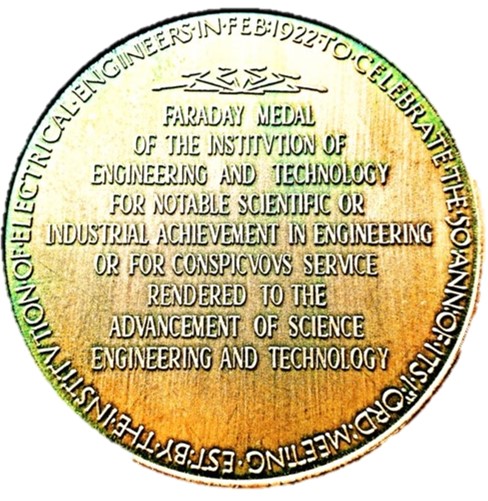Faraday Medal on:
[Wikipedia]
[Google]
[Amazon]
The Faraday Medal is a top international medal awarded by the UK

Image:Oheaviside.jpg, Heaviside: Transmission line theory, H-step function, 1922
Image:Charles Algernon Parsons.jpg, Parsons: Invented the modern steam turbine, 1923
Image:J.J Thomson.jpg, Thomson: Discovered
Institution of Engineering and Technology
The Institution of Engineering and Technology (IET) is a multidisciplinary professional engineering institution. The IET was formed in 2006 from two separate institutions: the Institution of Electrical Engineers (IEE), dating back to 1871, and ...
(IET) (previously called the Institution of Electrical Engineers
The Institution of Electrical Engineers (IEE) was a British professional organisation of electronics, electrical, manufacturing, and Information Technology professionals, especially electrical engineers. It began in 1871 as the Society of T ...
(IEE)). It is part of the IET Achievement Medals collection of awards. The medal is named after the famous Michael Faraday
Michael Faraday (; 22 September 1791 – 25 August 1867) was an English scientist who contributed to the study of electromagnetism and electrochemistry. His main discoveries include the principles underlying electromagnetic inducti ...
FRS, the father of electromagnetism. Faraday is widely recognized as a top scientist, engineer, chemist, and inventor. His electromagnetic induction principles have been widely used in electric motors and generators today.
Background
The Faraday medal is the IET's highest honour and one of the world's most prestigious awards for engineers and scientists. Winners include ground-breaking pioneers and inventors. First awarded in 1922, it is one of the oldest medals still being awarded today. The top medal is awarded annually to distinguished individuals who either for notable scientific or industrial achievement in engineering or for conspicuous service rendered to the advancement of science, engineering and technology, without restriction as regards to nationality, country of residence or membership of the Institution. The award was established in 1922 to commemorate the 50th Anniversary of the first Ordinary Meeting of the Society of Telegraph Engineers and is named afterMichael Faraday
Michael Faraday (; 22 September 1791 – 25 August 1867) was an English scientist who contributed to the study of electromagnetism and electrochemistry. His main discoveries include the principles underlying electromagnetic inducti ...
. Each year, the recipient received his/her award at a ceremony held in London that is hosted by the IET.
Winners

electrons
The electron ( or ) is a subatomic particle with a negative one elementary electric charge. Electrons belong to the first generation of the lepton particle family,
and are generally thought to be elementary particles because they have no ...
, 1925
Image:John Ambrose Fleming 1890.png, Fleming: Invented vacuum tubes, 1928
Image:Sir Ernest Rutherford LCCN2014716719 - restoration1.jpg, Rutherford: Discovered the atomic nucleus
The atomic nucleus is the small, dense region consisting of protons and neutrons at the center of an atom, discovered in 1911 by Ernest Rutherford based on the 1909 Geiger–Marsden gold foil experiment. After the discovery of the neutron ...
, 1930
Image:Appleton.jpg, Appleton: Discovered the Appleton layer, 1946
Image:Cockcroft.jpg, Cockcroft: "Split" the atomic nucleus, 1955
Image:Zvorykin0.jpg, Zworykin involved with inventing television and electron microscope
An electron microscope is a microscope that uses a beam of accelerated electrons as a source of illumination. As the wavelength of an electron can be up to 100,000 times shorter than that of visible light photons, electron microscopes have a hi ...
, 1965
Image:Maurice Vincent Wilkes 1980 (3).jpg, Wilkes: Built the first electronic computer
A computer is a machine that can be programmed to carry out sequences of arithmetic or logical operations (computation) automatically. Modern digital electronic computers can perform generic sets of operations known as programs. These program ...
, 1981
Image:Charles K. Kao cropped 2.jpg, Kao: Pioneered the development and use of fibre optics
An optical fiber, or optical fibre in Commonwealth English, is a flexible, transparent fiber made by drawing glass (silica) or plastic to a diameter slightly thicker than that of a human hair. Optical fibers are used most often as a means t ...
, 1989
Image:KnuthAtOpenContentAlliance.jpg, Knuth: Art of computer programming, 2011
Image:schouhamerimmink.jpg, Immink: Digital video and audio recording, 2015
Image:Bjarne-stroustrup (cropped).jpg, Stroustrup: Created C++
C++ (pronounced "C plus plus") is a high-level general-purpose programming language created by Danish computer scientist Bjarne Stroustrup as an extension of the C programming language, or "C with Classes". The language has expanded significan ...
, 2017
First 50 Years (1922–1972)
Next 50 Years (1973–2023)
See also
* Queen Elizabeth Prize for Engineering * Millennium Technology Prize * IEEE Medal of Honor *Turing Award
The ACM A. M. Turing Award is an annual prize given by the Association for Computing Machinery (ACM) for contributions of lasting and major technical importance to computer science. It is generally recognized as the highest distinction in comput ...
* Nobel Prize
The Nobel Prizes ( ; sv, Nobelpriset ; no, Nobelprisen ) are five separate prizes that, according to Alfred Nobel's will of 1895, are awarded to "those who, during the preceding year, have conferred the greatest benefit to humankind." Alfr ...
References
{{Michael Faraday British science and technology awards Awards established in 1922 1922 establishments in the United Kingdom Institution of Engineering and Technology Engineering awards Science and technology awards International awards Academic awards